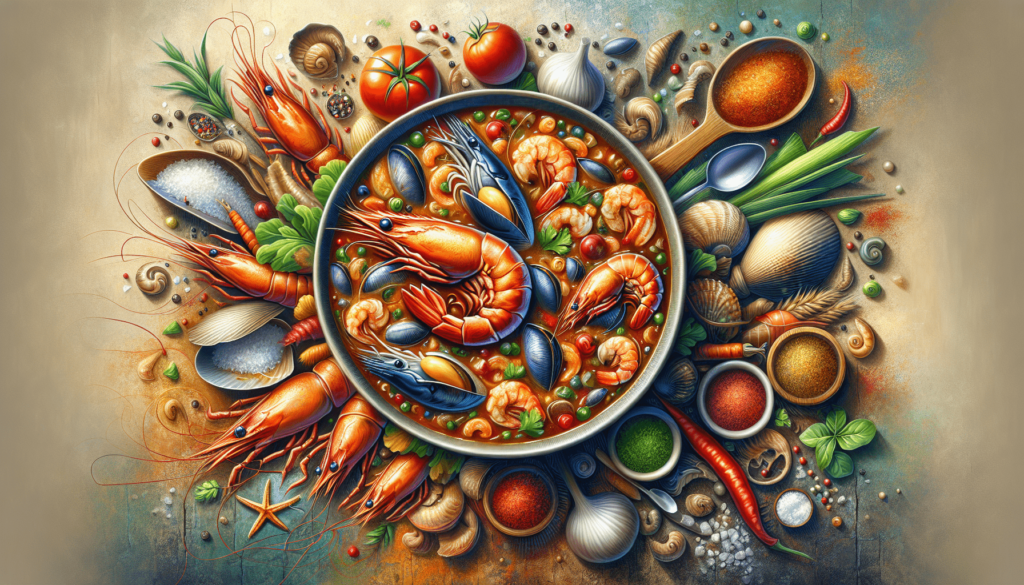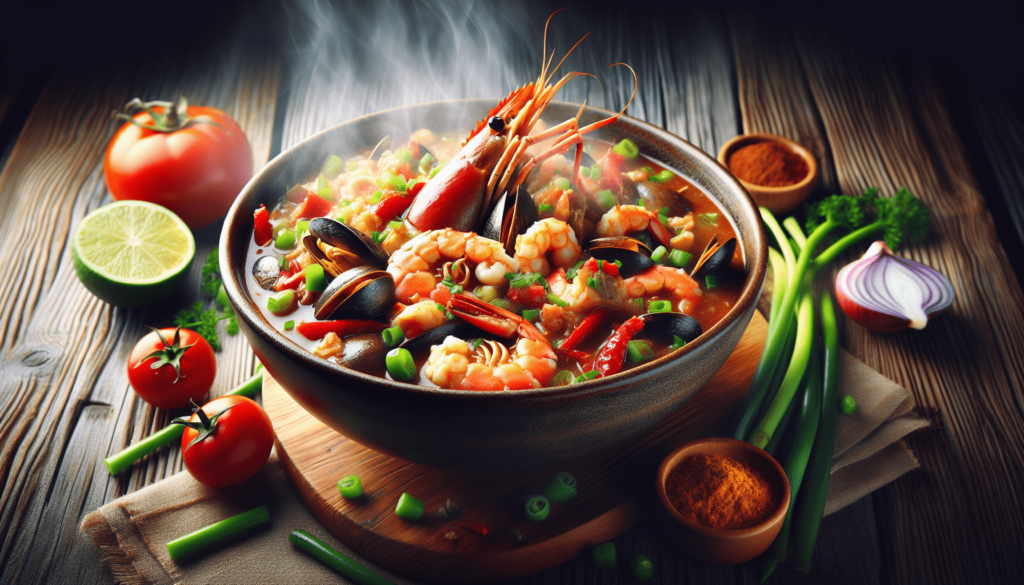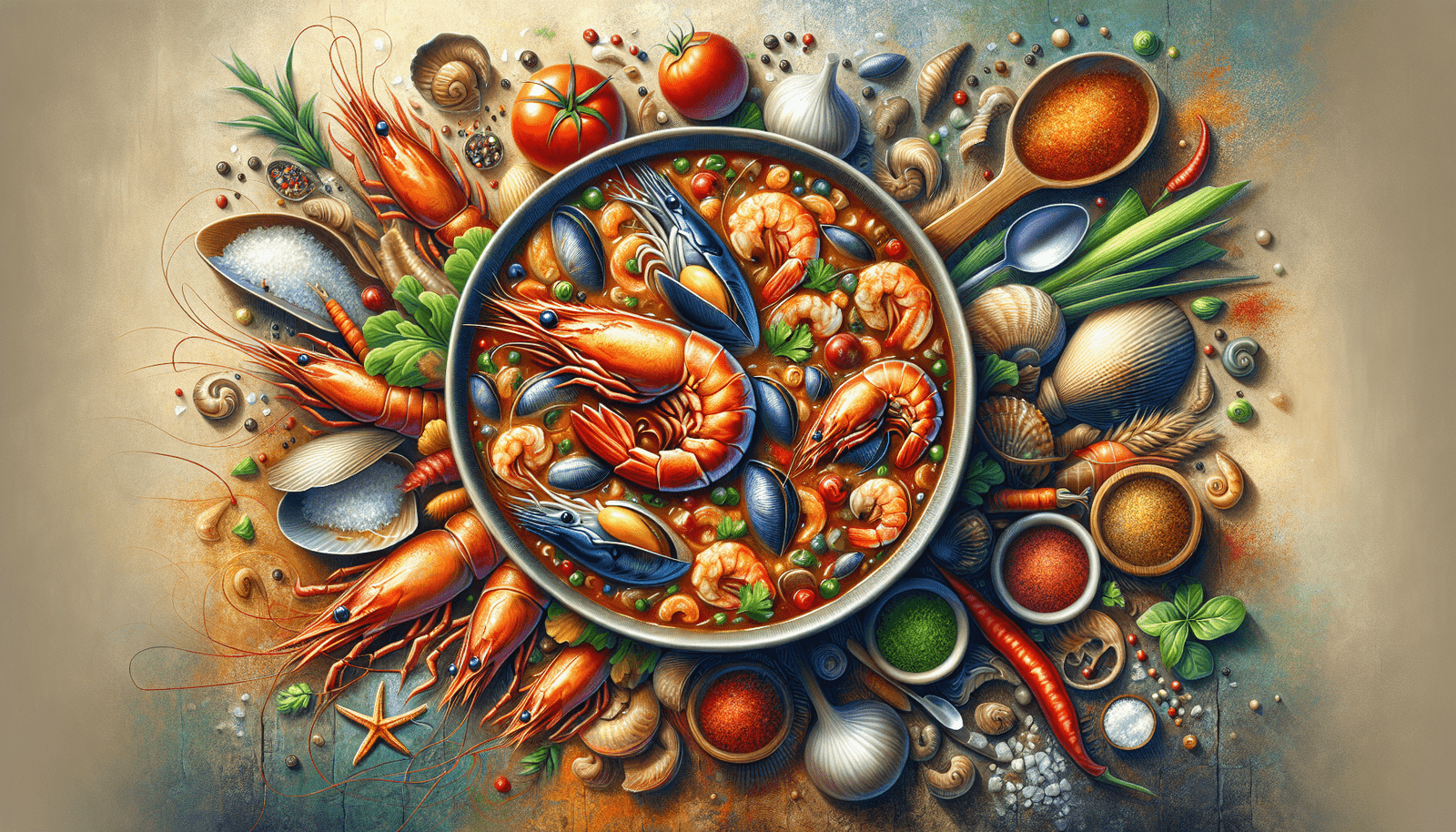Imagine yourself sitting at a cozy coastal restaurant, mesmerized by the aroma of a hearty seafood dish wafting through the air. Your taste buds tingle with anticipation as a bowl of Paula Deen’s indulgent gumbo recipe is placed before you. Succulent shrimp, tender crab meat, and plump oysters mingle together in a rich, flavorful broth, creating a symphony of taste that transports you straight to the bayou. Get ready to embark on a culinary adventure as we unveil the secrets of this quintessential Southern seafood gumbo, be prepared to be swept away by its deliciousness.

Ingredients
Fresh shrimp
Fresh shrimp is an essential ingredient in seafood gumbo. It adds a delicious, briny flavor and a delicate texture to the dish. When buying fresh shrimp, look for ones that are firm and have a pleasant smell of the sea. Make sure to clean and peel them before adding them to the gumbo.
Fish fillets
Fish fillets, such as cod or catfish, are another key component of seafood gumbo. They provide a meaty texture and a mild, slightly sweet flavor to the dish. Cut the fish fillets into bite-sized pieces so that they can easily cook and absorb the flavors of the gumbo.
Crabmeat
Crabmeat adds a rich and luxurious taste to seafood gumbo. It brings a slightly sweet and briny flavor that complements the other seafood ingredients. Make sure to remove any shells or cartilage from the crabmeat before adding it to the gumbo.
Smoked sausage
Smoked sausage is a flavorful addition to seafood gumbo. It adds depth and richness to the dish with its smoky and savory taste. Slice the smoked sausage into thin rounds or bite-sized pieces before cooking.
Onion
Onions provide a base flavor and aroma to the gumbo. They add a subtle sweetness and a savory note to the dish. Chop the onion into small pieces to ensure that it cooks evenly and blends well with the other ingredients.
Green bell pepper
Green bell peppers add a fresh and slightly tangy flavor to seafood gumbo. They also contribute to the vibrant color of the dish. Chop the green bell pepper into small dice to ensure even distribution of flavor.
Celery
Celery contributes a mild and herbaceous taste to the gumbo. It adds a satisfying crunch and freshness to the dish. Chop the celery into small pieces so that it cooks evenly and provides a nice texture to the gumbo.
Garlic
Garlic is a powerhouse of flavor in seafood gumbo. It adds a pungent and slightly spicy taste that enhances the overall taste of the dish. Chop or mince the garlic finely so that it distributes evenly throughout the gumbo.
Tomato
Tomatoes add a bright and acidic element to the gumbo. They balance the richness of the seafood and other ingredients. Dice the tomato into small pieces to ensure that it cooks quickly and releases its juices into the gumbo.
Flour
Flour is used to make the roux, which is the base of the gumbo. It adds thickness and richness to the dish. Make sure to use all-purpose flour for the roux.
Vegetable oil
Vegetable oil is used to make the roux. It provides a neutral flavor and helps in achieving a deep, dark brown color for the roux. Use a good quality vegetable oil for the best results.
Seafood stock
Seafood stock is a flavorful liquid made from simmering seafood shells, vegetables, and seasonings. It adds a rich and savory taste to the gumbo. If you don’t have seafood stock, you can use fish stock or even chicken or vegetable stock as a substitute.
Water
Water is used to dilute the gumbo and adjust its consistency. It is added along with the seafood stock to create the base of the gumbo.
Bay leaves
Bay leaves are aromatic herbs that add a subtle earthy and floral flavor to the gumbo. They infuse their essence into the dish while simmering and enhance the overall taste of the gumbo.
Thyme
Thyme is a versatile herb that adds a hint of earthiness and a mild floral note to the gumbo. It complements the flavors of the seafood and other ingredients. Use fresh thyme sprigs or dried thyme leaves, depending on what you have available.
Parsley
Parsley is a classic herb that adds a fresh and slightly peppery taste to the gumbo. It also provides a vibrant green color as a garnish. Chop the parsley finely and keep it aside for garnishing.
Salt
Salt is a crucial seasoning in any dish, including gumbo. It enhances the flavors of the other ingredients and brings out their natural taste. Adjust the amount of salt according to your preference and taste.
Black pepper
Black pepper adds a subtle heat and a floral aroma to the gumbo. It pairs well with the seafood and other ingredients. Use freshly ground black pepper for the best flavor.
Cayenne pepper
Cayenne pepper is the spice that adds heat and a distinct kick to the gumbo. It provides a fiery flavor and a pleasant warmth to the dish. Adjust the amount of cayenne pepper according to your desired level of spiciness.
Gumbo file powder
Gumbo file powder is made from ground sassafras leaves. It is a traditional thickening agent used in gumbo and adds a unique flavor to the dish. Sprinkle the gumbo file powder into the gumbo towards the end of cooking to thicken the broth and enhance the flavor.
Preparation
Clean and peel the shrimp
Start by cleaning and peeling the fresh shrimp. Remove the shells and tails, and devein them if necessary. Rinse the shrimp under cold water to remove any impurities. Pat them dry and set them aside.
Cut the fish fillets into bite-sized pieces
Take the fish fillets and cut them into bite-sized pieces. This will ensure that they cook evenly and are easy to eat in the gumbo. Set the fish aside.
Chop the onion, green bell pepper, celery, and garlic
Chop the onion, green bell pepper, celery, and mince the garlic. The size of the chop is a personal preference, but aim for small, uniform pieces to distribute the flavors evenly throughout the gumbo.
Dice the tomato
Dice the tomato into small pieces. This will release its juices and add a fresh taste to the gumbo. Set the diced tomato aside.
Slice the smoked sausage
Slice the smoked sausage into thin rounds or bite-sized pieces. This will allow the sausage to cook evenly and release its smoky flavor into the gumbo.
Make a roux by mixing flour and vegetable oil in a large pot over medium heat
To make the roux, heat a large pot over medium heat and add the vegetable oil. Once the oil is heated, gradually whisk in the flour. Keep stirring continuously to prevent any lumps from forming.
Stir constantly until the roux turns dark brown (around 15-20 minutes)
Continue stirring the flour and oil mixture until it turns into a dark brown color. Be patient during this step, as it is crucial to achieving the rich flavor of the gumbo. This process usually takes around 15-20 minutes.
Add the chopped vegetables and garlic to the roux
Once the roux has reached the desired color, add the chopped vegetables and minced garlic to the pot. Stir well to coat the vegetables with the roux. This step allows the flavors to meld together and develop a depth of taste.
Cook until the vegetables are tender
Cook the vegetables in the roux until they become tender. This usually takes around 5-7 minutes, but keep an eye on them to prevent burning or overcooking.
Add the sliced smoked sausage and cook for a few more minutes
Add the sliced smoked sausage to the pot and cook for a few more minutes. This will allow the sausage to release its flavors and complement the other ingredients in the gumbo.
Pour in the seafood stock and water
Carefully pour in the seafood stock and water into the pot. The liquid will help create the base of the gumbo and provide a delicious broth for the seafood and other ingredients to cook in.
Add bay leaves, thyme, parsley, salt, black pepper, and cayenne pepper
Add bay leaves, thyme sprigs, parsley, salt, black pepper, and cayenne pepper to the pot. These seasonings will infuse their flavors into the gumbo and enhance the overall taste. Adjust the amount of salt and cayenne pepper according to your taste preferences.
Bring the mixture to a boil, then reduce heat and simmer for 30 minutes
Bring the mixture to a boil over high heat. Once it reaches a boil, reduce the heat to low and let the gumbo simmer for about 30 minutes. This allows the flavors to develop and meld together.
Add the shrimp, fish fillets, and crabmeat to the pot
Add the shrimp, fish fillets, and crabmeat to the pot of simmering gumbo. These seafood ingredients will cook relatively quickly and contribute their unique flavors to the dish.
Cook for another 10 minutes or until the seafood is cooked through
Cook the gumbo for another 10 minutes or until the seafood is cooked through. Be careful not to overcook the seafood as it can become tough and rubbery.
Remove from heat and sprinkle in gumbo file powder
Once the seafood is cooked through, remove the pot from the heat. Sprinkle in the gumbo file powder and stir well to combine. The gumbo file powder will thicken the broth and add a distinct flavor to the gumbo.
Stir well to combine and let the gumbo sit for a few minutes before serving
After adding the gumbo file powder, stir the gumbo well to ensure that it is evenly distributed. Let the gumbo sit for a few minutes before serving to allow the flavors to meld together.
Serving
Serve the gumbo hot
Seafood gumbo is best served hot to enjoy all the flavors and aromas. Ladle the gumbo into bowls and make sure to serve it while it is still steaming hot.
Optional: Garnish with chopped parsley or green onions
For an added touch of freshness and color, garnish the gumbo with chopped parsley or green onions. This will provide a pop of green and a hint of herbaceous flavor to the dish.
Serve with rice or crusty French bread
To complete the meal, serve the gumbo with a side of rice or crusty French bread. The rice can be served on the side or ladled into the gumbo for a heartier meal. The crusty bread is perfect for dipping into the flavorful broth.
Tips
Use fresh seafood for the best flavor
Fresh seafood is essential for a delicious seafood gumbo. Look for the freshest shrimp, fish fillets, and crabmeat available. Using high-quality seafood will elevate the taste of the gumbo and ensure a delightful dining experience.
Prep all the ingredients before starting the cooking process
To make the cooking process smoother and more efficient, prep all the ingredients before starting. This includes cleaning and peeling the shrimp, chopping the vegetables, and gathering all the seasonings and spices. Having everything ready will allow you to focus on the cooking process and ensure a well-prepared gumbo.
Adjust the amount of cayenne pepper based on your desired level of spiciness
Cayenne pepper adds heat to the gumbo, but the amount can be adjusted to suit your personal preference. If you prefer a mild gumbo, use less cayenne pepper. If you like it spicier, feel free to add more.
Add more seafood stock or water if a thinner consistency is preferred
If you prefer a thinner consistency in your gumbo, you can add more seafood stock or water. Adjust the amount according to your desired consistency. Keep in mind that the gumbo will thicken slightly as it simmers.
Let the gumbo sit for a while after adding the gumbo file powder to allow the flavors to meld together
After adding the gumbo file powder, let the gumbo sit for a few minutes before serving. This will allow the flavors to meld together and create a harmonious taste throughout the dish. The gumbo will also thicken slightly during this time.
Store any leftovers in an airtight container in the refrigerator for up to 3 days
If you have any leftovers, store them in an airtight container in the refrigerator. Seafood gumbo can be kept for up to 3 days. Make sure to reheat it thoroughly before serving.

Variations
Add okra for a traditional gumbo ingredient
Okra is a classic ingredient in gumbo and adds a unique flavor and texture. It acts as a thickening agent and adds a slightly slimy texture to the gumbo. If you enjoy okra, consider adding it to your gumbo for a traditional touch.
Include other seafood such as scallops or mussels
While the base recipe includes shrimp and crabmeat, you can always experiment and add other types of seafood to your gumbo. Scallops and mussels are excellent options that will add variety and depth of flavor to the dish.
Experiment with different spices and herbs for a unique flavor profile
Feel free to experiment with different spices and herbs to create your own unique flavor profile. You can add smoky paprika, oregano, or even a dash of hot sauce for an extra kick. Customize the gumbo to your taste preferences and have fun exploring different flavors.
Make a roux using butter instead of vegetable oil for a richer taste
If you prefer a richer taste, you can make the roux using butter instead of vegetable oil. This will add a buttery flavor to the gumbo and lend it a velvety texture. Keep in mind that butter has a lower smoke point, so adjust the heat accordingly while making the roux.


